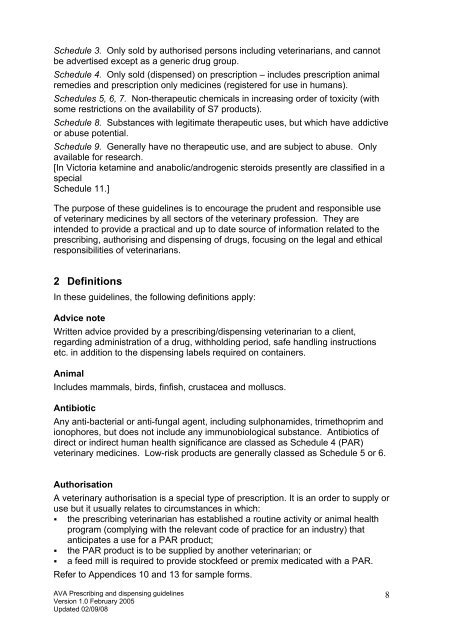Guidelines for Prescribing, Authorising and Dispensing - Australian ...
Guidelines for Prescribing, Authorising and Dispensing - Australian ...
Guidelines for Prescribing, Authorising and Dispensing - Australian ...
Create successful ePaper yourself
Turn your PDF publications into a flip-book with our unique Google optimized e-Paper software.
Schedule 3. Only sold by authorised persons including veterinarians, <strong>and</strong> cannot<br />
be advertised except as a generic drug group.<br />
Schedule 4. Only sold (dispensed) on prescription – includes prescription animal<br />
remedies <strong>and</strong> prescription only medicines (registered <strong>for</strong> use in humans).<br />
Schedules 5, 6, 7. Non-therapeutic chemicals in increasing order of toxicity (with<br />
some restrictions on the availability of S7 products).<br />
Schedule 8. Substances with legitimate therapeutic uses, but which have addictive<br />
or abuse potential.<br />
Schedule 9. Generally have no therapeutic use, <strong>and</strong> are subject to abuse. Only<br />
available <strong>for</strong> research.<br />
[In Victoria ketamine <strong>and</strong> anabolic/<strong>and</strong>rogenic steroids presently are classified in a<br />
special<br />
Schedule 11.]<br />
The purpose of these guidelines is to encourage the prudent <strong>and</strong> responsible use<br />
of veterinary medicines by all sectors of the veterinary profession. They are<br />
intended to provide a practical <strong>and</strong> up to date source of in<strong>for</strong>mation related to the<br />
prescribing, authorising <strong>and</strong> dispensing of drugs, focusing on the legal <strong>and</strong> ethical<br />
responsibilities of veterinarians.<br />
2 Definitions<br />
In these guidelines, the following definitions apply:<br />
Advice note<br />
Written advice provided by a prescribing/dispensing veterinarian to a client,<br />
regarding administration of a drug, withholding period, safe h<strong>and</strong>ling instructions<br />
etc. in addition to the dispensing labels required on containers.<br />
Animal<br />
Includes mammals, birds, finfish, crustacea <strong>and</strong> molluscs.<br />
Antibiotic<br />
Any anti-bacterial or anti-fungal agent, including sulphonamides, trimethoprim <strong>and</strong><br />
ionophores, but does not include any immunobiological substance. Antibiotics of<br />
direct or indirect human health significance are classed as Schedule 4 (PAR)<br />
veterinary medicines. Low-risk products are generally classed as Schedule 5 or 6.<br />
Authorisation<br />
A veterinary authorisation is a special type of prescription. It is an order to supply or<br />
use but it usually relates to circumstances in which:<br />
� the prescribing veterinarian has established a routine activity or animal health<br />
program (complying with the relevant code of practice <strong>for</strong> an industry) that<br />
anticipates a use <strong>for</strong> a PAR product;<br />
� the PAR product is to be supplied by another veterinarian; or<br />
� a feed mill is required to provide stockfeed or premix medicated with a PAR.<br />
Refer to Appendices 10 <strong>and</strong> 13 <strong>for</strong> sample <strong>for</strong>ms.<br />
AVA <strong>Prescribing</strong> <strong>and</strong> dispensing guidelines<br />
Version 1.0 February 2005<br />
Updated 02/09/08<br />
8

















